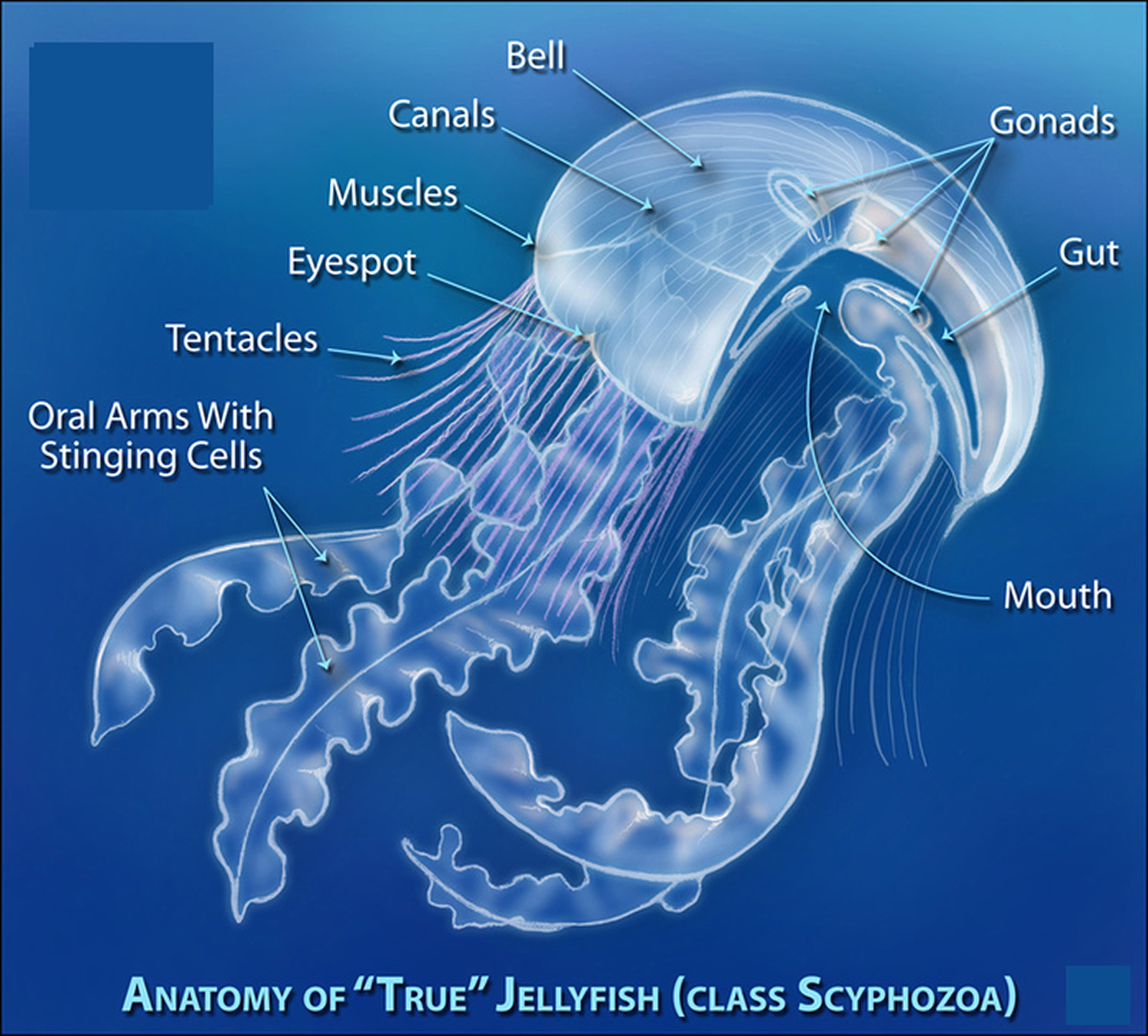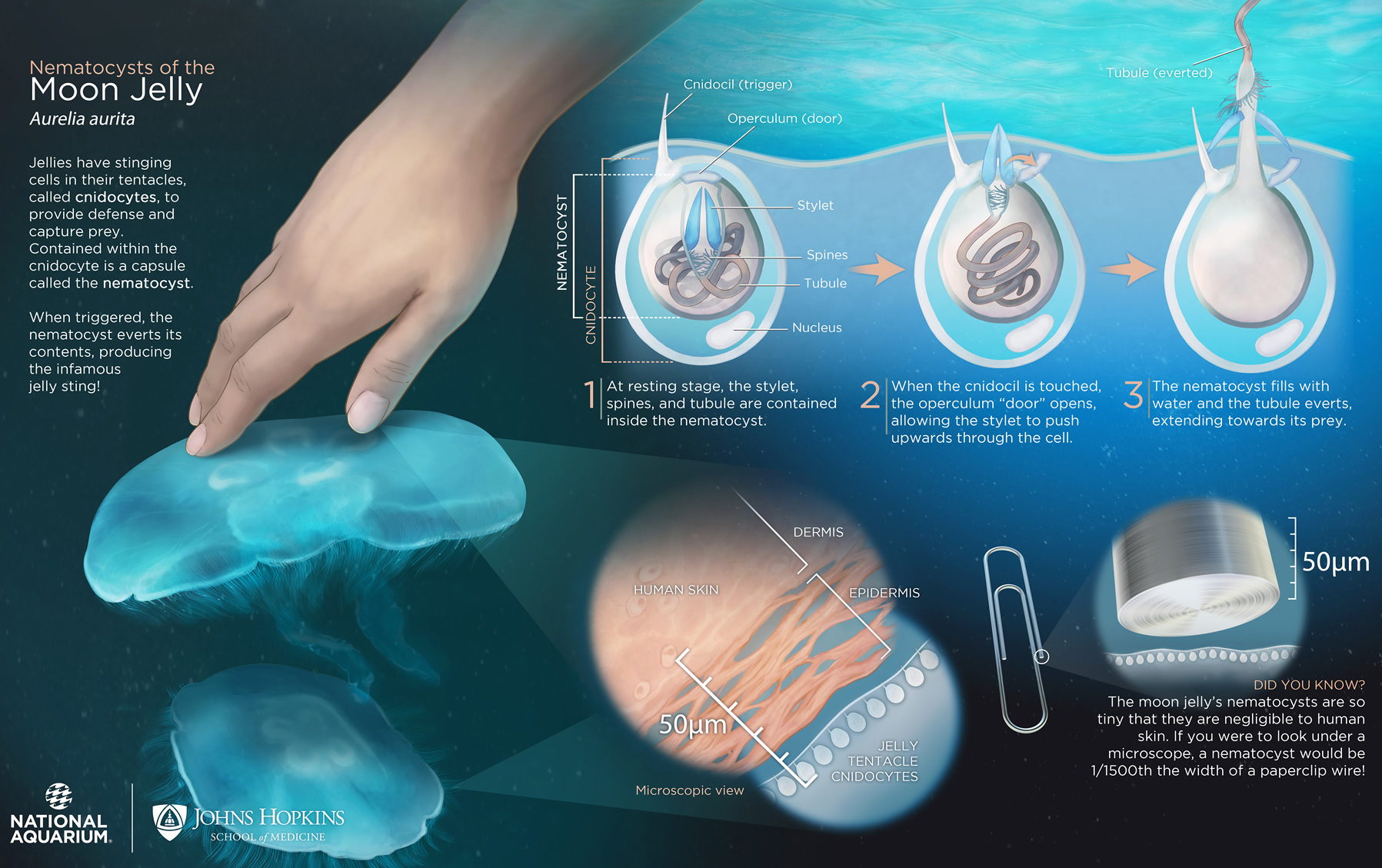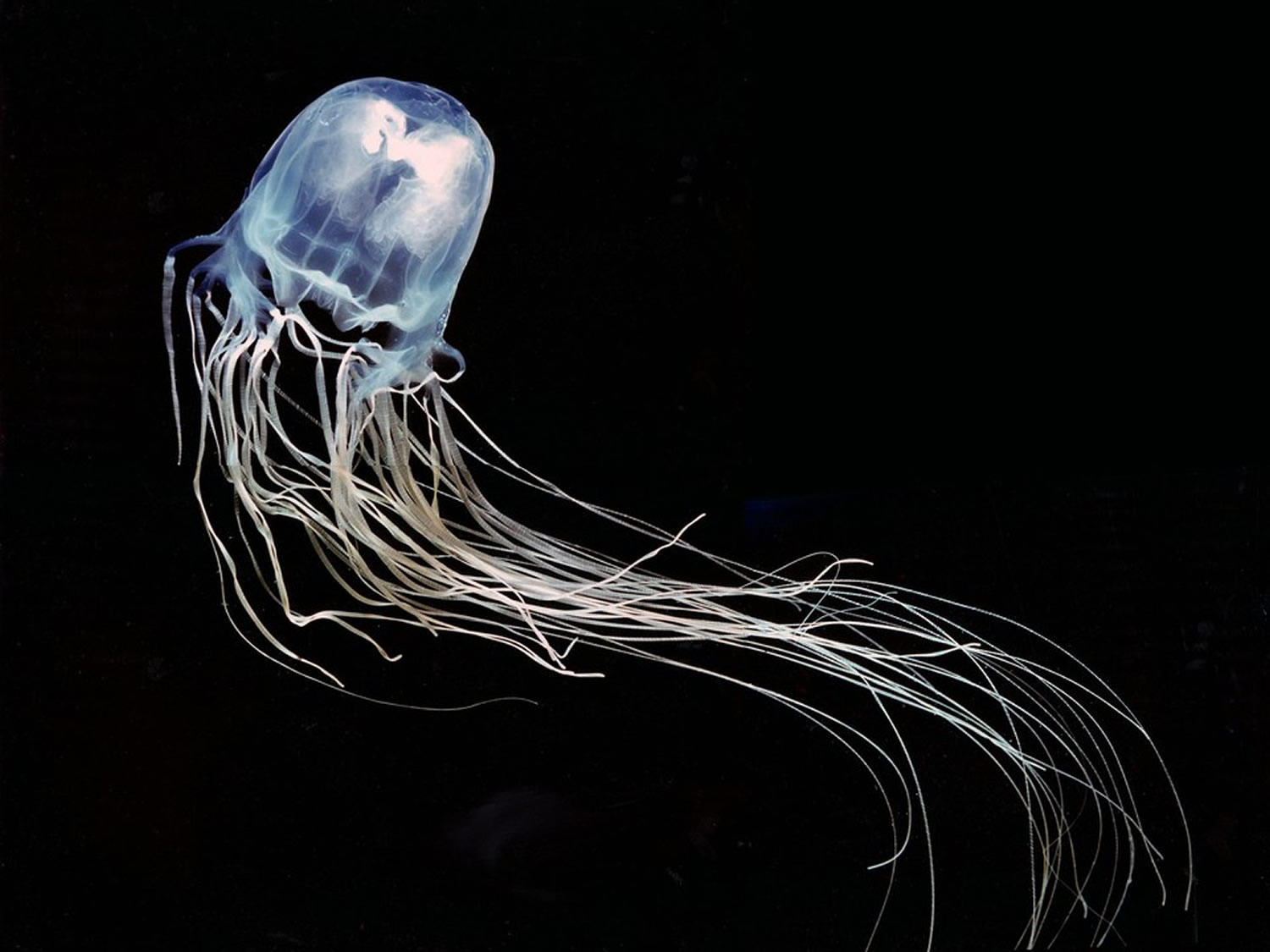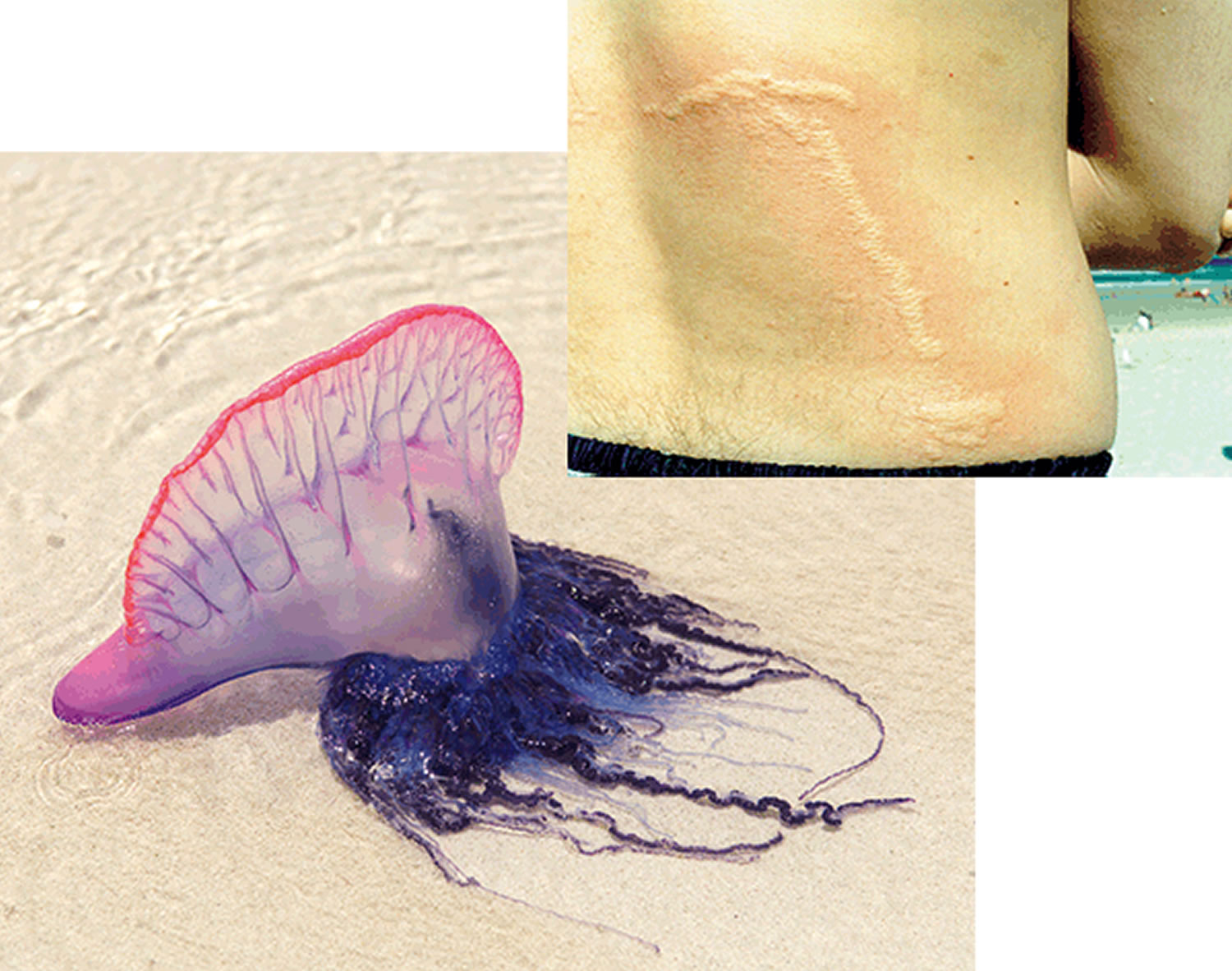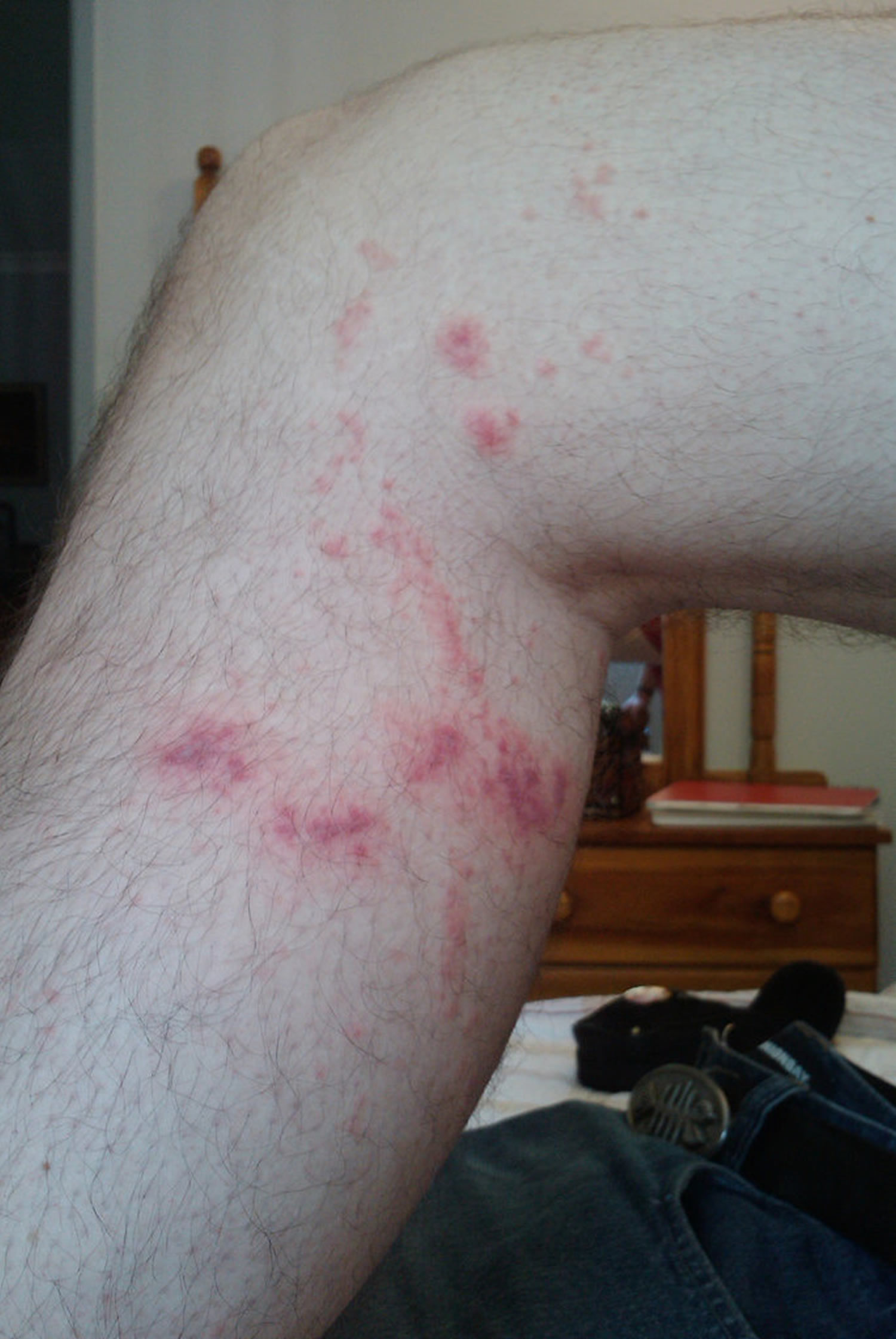Contents
Jellyfish sting
Jellyfish cause stings when their tentacles contact skin. Contact triggers the jellyfish to release venom from millions of tiny stinging cells (nematocytes) covering the tentacles (see Figures 1 and 2). The long tentacles trailing from the jellyfish body can inject you with venom from thousands of microscopic barbed stingers. The venom is released via a harpoon-like mechanism that injects venom into the dermis (Figure 2).
Jellyfish stings vary greatly in severity. Most often they result in immediate pain and red, irritated marks on the skin. Some jellyfish stings may cause more whole-body (systemic) illness. And in rare cases jellyfish stings are life-threatening.
Sting severity is related to:
- the number of stinging cells that fire (nematocytes), which depends on the amount of tentacle contact with skin
- the potency of injected venom, which depends on the species.
It is important to note that there are a range of marine creatures that can sting and cause envenomation. Geographic location may provide information and a likely cause. The major box jellyfish (Chironex fleckeri) and jellyfish causing Irukandji syndrome (carybdeids, Carukia barnesi) are more common in tropical regions. Stings from these creatures can be potentially fatal, and require different first aid and management.
The most dangerous jellyfish, the major box jellyfish (Chironex fleckeri), has a highly potent venom as well as multiple long tentacles (see Figure 3). Deaths from the major box jellyfish have occurred in Northern Australia, but remain rare. Bluebottles (Physalia species) are the most common cause of jellyfish stings worldwide and in Australia, although few people present to hospital. Stings occur at times when swarms of bluebottles are in shallow coastal waters or along the shoreline. Irukandji-like stings occur in Northern Australia, most commonly due to Carukia barnesi, but cases have occurred less commonly in other parts of Australia and from other jellyfish types.
- Most people don’t know what type of jellyfish has stung them, so first aid needs to be simple, easily understood, and easily performed.
Figure 1. Jellyfish anatomy
Figure 2. Jellyfish stinging cells (Nematocytes)
Figure 3. Box Jellyfish (Chironex fleckeri)
Bluebottle stings
The bluebottle (Physalia spp.) – or Portuguese man o’ war – is not a true jellyfish, but a colony of individual organisms. Bluebottles are most common in non-tropical areas and may be seen washed up on beaches during high tide (Figure 4). There are around 10 000 cases of bluebottle stings on the east coast of Australia each year.
A sting from a bluebottle causes an immediate sharp pain and acute inflammatory skin reaction, which has a linear appearance (Figures 5 and 8). The pain is worsened if the tentacles are moved or the area rubbed. The intense pain can last from minutes to many hours, and can be followed by a dull ache involving the joints.
The main symptom and management priority is usually pain relief.
Figure 4. Bluebottles (Portuguese man o’war)
Figure 5. Bluebottle sting
Irukandji jellyfish – Carukia barnesi
Irukandji jellyfish are the smallest and one of the most venomous jellyfish in the world. They inhabit the marine waters of Australia, Florida and the U.S.A. They are able to fire their stingers into their victim, causing symptoms collectively known as Irukandji syndrome. Their adult size is roughly a cubic centimetre (1 cm³). There are about 16 known species of Irukandji: Carukia barnesi, Malo kingi, Malo maximus, Malo filipina and Malo bella are the best-known.
The symptoms of Irukandji syndrome were first documented by Hugo Flecker in 1952. They were named after the Irukandji people whose country stretches along the coastal strip north of Cairns, Queensland, Australia. The first of these jellyfish, Carukia barnesi, was identified in 1964 by Jack Barnes; to prove it was the cause of Irukandji syndrome, he captured the tiny jelly and allowed it to sting him while his son and a lifeguard observed the effects. He was lucky and they only ended up mildly sick.
Unlike most jellyfish, which have stingers only on their tentacles, the Irukandji also has stingers on its bell. Biologists have yet to discover the purpose of this unique characteristic. The hypothesis is that the feature enables the jellyfish to be more likely to catch its prey of small fish.
Irukandji jellyfish have the ability to fire stingers from the tips of their tentacles and inject venom.
Irukandji jellyfish’s stings are so severe they can cause fatal brain hemorrhages and on average send 50-100 people to the hospital annually.
Irukandji jellyfish is capable of delivering a sting 100 times as potent as that of a cobra and 1,000 times stronger than a tarantula.
Irukandji syndrome
The Irukandji jellyfish sting is moderately irritating; the severe syndrome is delayed for 5–120 minutes (30 minutes on average). The symptoms last from hours to weeks, and victims usually require hospitalization. Irukandji-like stings can often initially go unnoticed in divers in deep water. Within 20–30 minutes they develop severe, excruciating generalized pain (abdominal, back and chest pain). There is rarely local pain and often there is only a minimal skin reaction.
Irukandji syndrome is produced by a small amount of venom and induces excruciating muscle cramps in the arms and legs, severe pain in the back and kidneys, a burning sensation of the skin and face, headaches, nausea, restlessness, sweating, vomiting, an increase in heart rate and blood pressure, and psychological phenomena such as the feeling of impending doom. Animal studies have shown that Irukandji jellyfish (Carukia barnesi) envenoming is associated with the release of endogenous catecholamines, consistent with a sympathomimetic toxidrome 1. The venom contains a sodium channel modulator 2. The patient is often distressed and may have associated agitation, nausea, vomiting and diaphoresis. Patients can develop tachycardia and hypertension, which may result in myocardial injury and pulmonary odema. Electrocardiogram (ECG) ST segment and T wave changes, and elevated troponins due to myocardial injury can occur.
Contrary to belief, researchers from James Cook University and Cairns hospital in far north Queensland, Australia have found that vinegar promotes the discharge of jellyfish venom. “You can increase the venom load in your victim by 50 per cent,” says Associate Professor Jamie Seymour from the Australian Institute of Tropical Health and Medicine at the university. “That’s a big amount, and that’s enough to make the difference, we think, between someone surviving and somebody dying.” 3 However, other research indicates that while vinegar may increase the discharge from triggered stingers, it also prevents untriggered stingers from discharging; since the majority of stingers do not trigger immediately, the Australian Resuscitation Council continues to recommend using vinegar 4.
Treatment is symptomatic, with antihistamines and anti-hypertensive drugs used to control inflammation and hypertension; intravenous opiates, such as morphine and fentanyl, are used to control the pain 3. Magnesium sulfate has been used to reduce pain and hypertension in Irukandji syndrome 5, although it has had no effect in other cases 6.
Irukandji jellyfish are usually found near the coast, attracted by the warmer water, but blooms have been seen as far as five kilometers offshore. When properly treated, a single sting is normally not fatal, but two people in Australia are believed to have died from Irukandji stings in 2002 during a rash of incidents on Australia’s northern coast attributed to these jellyfish 7 —greatly increasing public awareness of Irukandji syndrome. It is unknown how many other deaths from Irukandji syndrome have been wrongly attributed to other causes. It is also unknown which jellyfish species can cause Irukandji syndrome apart from Carukia barnesi and Malo kingi.
Figure 6. Irukandji jellyfish (Carukia barnesi) are very small, with a bell about 5 millimeters (0.20 in) to 25 millimeters (0.98 in) wide (or wider) and four long tentacles, which range in length from just a few centimeters up to 1 meter (3.3 ft) in length.
Figure 7. Irukandji jellyfish (Carukia barnesi)
What does a jellyfish sting look like
People stung by jellyfish present in one of two ways:
- the majority present with an immediately painful, linear/tentacle-like sting
- a minority present with delayed pain – Irukandji-like sting.
Linear/tentacle stings usually result in local pain where the tentacles contact skin. There is a raised erythematous or urticarial lesion that is distinctive and can last hours to days (Figures 5 and 8). Typically, the pain resolves within 1–2 hours. Mild systemic symptoms such as nausea, vomiting and malaise occur uncommonly. Rarely, there may be delayed reactions such as papular urticarial rashes along the sting sites [Box Jellyfish (Chironex fleckeri)], bullous lesions or keloid scarring (usually in predisposed individuals). Although the presentation of most Box Jellyfish (Chironex fleckeri) stings is similar to other stings, severe envenoming resulting in cardiovascular collapse and death can occur. These cases are characterized by significant hypotension within 20–30 minutes, which leads to death without basic life support.
Figure 8. Bluebottle sting
What to put on jellyfish sting
Bluebottle and minor jellyfish (Physalia spp, Pelagia, Cyanea, Aurelia, some Carybdidae)
Clinical effects
Typically, these stings cause immediate local intense pain for 1–2 hours, and associated linear erythematous eruptions.
First Aid
- Wash sting site with seawater and remove tentacles
- Hot water immersion (45°C or 113 °F for 20 minutes*)
- Avoid vinegar as it may worsen the pain
*Evidence only for bluebottle stings but likely to work with other minor jellyfish stings 8
How to provide the heat
Hot water immersion can be applied after initial treatment, but to be effective, heat needs to be applied as soon as possible after stinging.
Apply hot, but not scalding, water (ideally at 42–45°C or 107.6-113 °F), or a heat pack for 30–90 minutes or until the pain resolves. This can be done via:
- hot shower (which has the advantage of being able to vary the temperature)
- basin, bucket or bath filled with hot water
- heat packs.
As hot water may not be readily available at beach locations, consider self-heating heat packs for inclusion in first aid kits. Heat packs should have the capacity to reach a minimum 42°C (107.6 °F).
Hot water (or heat) is proposed to work in one of two ways: via deactivation of heat labile proteins in the venom, and via modulation of pain receptors (the gate theory).
Anything else?
Although topical heat may be effective for Hawaiian box jellyfish, there are no studies suggesting it is effective for Australian box jellyfish (Chironex fleckeri), or for preventing Irukandji syndrome, which may follow stings by Carukia barnesi.
For bluebottle stings, do not apply alcohol and do not apply vinegar. While vinegar is appropriate for Chironex fleckeri stings, vinegar may cause bluebottle nematocysts to discharge.
Further medical management
Generally no further intervention is necessary.
Clinical effects
These stings cause severe local pain and associated erythematous eruptions along the lines of tentacle contact. In large surface area contact exposures cardiovascular collapse and death can occur.
First Aid
- Domestic vinegar should be poured liberally over any adhering tentacles to inactivate the stinging cells (nematocysts) as soon as possible. Flood the area with vinegar for at least 30 seconds.
The use of vinegar for jellyfish stings is to prevent the firing of undischarged stinging cells and the injection of more venom. Vinegar will not decrease pain or lessen the effects of the venom.
- If vinegar is not available, wash the area well using sea water (not fresh water) and pick off tentacles.
Never try to substitute methylated spirits or alcohol, which will cause the nematocysts to discharge and worsen the sting.
- Commence immediate cardiopulmonary resuscitation (CPR) on any patient who is unconscious.
- Dial your local emergency number for an ambulance and seek help from a lifeguard.
- A cold pack or ice in a sealed, dry plastic bag may help relieve pain. Take care not to get fresh water on the area as it could activate further stinging cells.
Note: In a a randomized controlled trial comparing the effect of hot water immersion versus icepacks for treating the pain of Chironex fleckeri (major box jellyfish) stings 9 — Hot water immersion was no more effective than icepacks for reducing the acute pain of box jellyfish stings, but increased emergency department length of stay by about 30 minutes.
Further medical management
Transport to hospital for:
- Analgesia (oral and IV)
- Consider antivenom in patients with cardiovascular collapse not responsive to standard advanced life support
Clinical effects
Irukandji syndrome is typically delayed (20–30 mins) with generalized severe pain and systemic effects (tachycardia, agitation, hypertension) and in a small proportion cardiac injury/pulmonary odema.
First Aid
Apply vinegar and remove any remaining tentacles with gloves.
- Domestic vinegar should be poured liberally over any adhering tentacles to inactivate the stinging cells (nematocysts) as soon as possible. Flood the area with vinegar for at least 30 seconds.
The use of vinegar for jellyfish stings is to prevent the firing of undischarged stinging cells and the injection of more venom. Vinegar will not decrease pain or lessen the effects of the venom.
- If vinegar is not available, wash the area well using sea water (NOT fresh water) and pick off tentacles. Fresh water on the area could activate further stinging cells.
Never try to substitute methylated spirits or alcohol, which will cause the nematocysts to discharge and worsen the sting.
- Artificial respiration and cardiac massage (cardiopulmonary resuscitation – CPR) may be required.
- Dial your local emergency number for an ambulance and seek help from a lifeguard.
- A cold pack or ice in a sealed, dry plastic bag may help relieve pain. (Take care not to get fresh water on the area as it could activate further stinging cells.)
Although most of the nematocysts (stinging cells) will have fired, the small number of remaining unfired cells could cause a mild prickling sensation to be felt by the rescuer. This will not be harmful to the rescuer. Wearing gloves is known to afford protection when picking of the adherent tentacles from the victim.
Although most of the tentacle stinging cells are likely to have already fired, by removing the tentacles, any unfired nematocysts are also removed. This may lessen the venom load to the patient and this reduction may make a difference to the victim’s outcome 10.
Further medical management
Transport to hospital for:
- Analgesia (oral and intravenous)
- Investigation and treatment of cardiac effects (troponin, electrocardiography, echocardiogram)
- Cardiac monitoring
Antivenom is available, and is recommended for all but minor stings.
AVOID These Techniques for Jellyfish Stings
These actions are unhelpful, unproved or may even be harmful:
- Rinsing with human urine
- Scraping out stingers
- Rinsing with fresh water
- Applying meat tenderizer
- Applying alcohol, ethanol or ammonia
- Rubbing with a towel
- Applying pressure bandages
How do jellyfish sting
Jellyfish tentacles contain microscopic barbed stingers. Each stinger has a tiny bulb that holds venom and a coiled, sharp-tipped tube. The jellyfish uses the venom to protect itself and kill prey.
When you brush against a tentacle, tiny triggers on its surface release the stingers. The tube penetrates the skin and releases venom. It affects the immediate area of contact and may enter the bloodstream.
Jellyfish that have washed up on a beach may still release venomous stingers if touched.
Types of jellyfish
While many types of jellyfish are relatively harmless to humans, some can cause severe pain and are more likely to cause a systemic reaction. These jellyfish cause more-serious problems in people:
- Box jellyfish. Box jellyfish can cause intense pain. Life-threatening reactions — although rare — are more common with this type. The more dangerous species of box jellyfish are in the warm waters of the Pacific and Indian oceans.
- Portuguese man-of-war. Also called bluebottle jellyfish, Portuguese man-of-war jellyfish live mostly in warmer seas. This type has a blue or purplish gas-filled bubble that keeps it afloat on the water and acts as a sail.
- Sea nettle. Common in both warm and cool seawaters, sea nettles live along the northeast coast of the United States and are abundant in the Chesapeake Bay.
- Lion’s mane jellyfish. These are the world’s largest jellyfish, with a body diameter of more than 3 feet (1 meter). They’re most common in cooler, northern regions of the Pacific and Atlantic oceans.
Risk factors for getting stung by jellyfish
Conditions that increase your risk of getting stung by jellyfish include:
- Swimming at times when jellyfish appear in large numbers (a jellyfish bloom)
- Swimming or diving in jellyfish areas without protective clothing
- Playing or sunbathing where jellyfish are washed up on the beach
- Swimming in a place known to have many jellyfish
Jellyfish sting complications
Possible complications of a jellyfish sting include:
- Delayed hypersensitivity reaction, causing blisters, rash or other skin irritations one to two weeks after the sting
- Irukandji syndrome, which causes chest and stomach pain, high blood pressure and heart problems
Jellyfish sting prevention
The following tips can help you avoid jellyfish stings:
- Wear a protective suit. When swimming or diving in areas where jellyfish stings are possible, wear a wet suit or other protective clothing. Diving stores sell protective “skin suits” or “stinger suits” made of thin, high-tech fabric. Consider protective footwear as stings can also occur while wading in shallow water.
- Get information about conditions. Talk to lifeguards, local residents or officials with a local health department before swimming or diving in coastal waters, especially in areas where jellyfish are common.
- Avoid water during jellyfish season. Stay out of the water when jellyfish numbers are high.
Jellyfish sting symptoms
Immediate, excruciating pain. Whip-like sting marks on the skin – redness and swelling.
Also nausea, vomiting, sweating, restlessness, headache and collapse. May stop breathing and go into cardiac arrest within a few minutes of being stung.
Common signs and symptoms of jellyfish stings include:
- Burning, prickling, stinging pain
- Red, brown or purplish tracks on the skin — a “print” of the tentacles’ contact with your skin
- Itching
- Swelling
- Throbbing pain that radiates up a leg or an arm
Severe jellyfish stings can affect multiple body systems. These reactions may appear rapidly or several hours after the stings. Signs and symptoms of severe jellyfish stings include:
- Stomach pain, nausea and vomiting
- Headache
- Muscle pain or spasms
- Weakness, drowsiness, fainting and confusion
- Difficulty breathing
- Heart problems
The severity of your reaction depends on:
- The type and size of the jellyfish
- Your age, size and health, with severe reactions more likely in children and people in poor health
- How long you were exposed to the stingers
- How much of your skin is affected
Bluebottle or Portuguese man o’war
Although painful, bluebottle stings do not usually cause any lasting damage. First aid for bluebottle stings consists of the following.
- Vinegar is NOT recommended.
- Remove any tentacles with tweezers, forceps or fingers (this is not dangerous to the rescuer; you may experience a harmless prickling feeling).
- DO NOT rub the area.
- DO NOT wash off with fresh water — use sea water.
- Immerse the affected area in hot water (no hotter than the rescuer can comfortably tolerate) for 20 minutes to relieve pain.
- If pain is not relieved by heat, or hot water is not available, stings may respond to ice packs or anesthetic creams or lotions.
- For persistent or generalized pain, or if the sting area is large or involves sensitive areas, call an ambulance and seek assistance from a lifeguard if available.
Irukandji syndrome
Irukandji syndrome can develop about 30 minutes after being stung by some small and medium-sized jellyfish. It can be fatal. First aid for Irukandji syndrome includes the following.
- Call for medical assistance, either via a lifeguard or dial 000 for an ambulance.
- Liberally douse the stung area with vinegar.
- The person must be taken to hospital for pain relief and treatment of symptoms.
Signs and symptoms of Irukandji syndrome
The sting may be mild or not painful, and the jellyfish may be too small to be seen.
Symptoms include severe low back pain, generalized cramping pain, vomiting, sweating, difficulty breathing, restlessness and anxiety. Dangerously high blood pressure may develop.
Jellyfish sting treatment
How to treat a jellyfish sting
Most people don’t know what type of jellyfish has stung them, so first aid needs to be simple, easily understood, and easily performed.
Linear/tentacle stings
In all cases the tentacles should be carefully removed, either by washing with seawater, or by hand. For bluebottles, the sting site should be immersed in hot water for 20 minutes. This treatment is supported by an open-labelled randomized controlled trial that showed hot water immersion (113 °F or 45°C) for 20 minutes was effective, compared with ice packs 8. Immersion should be limited to 20 minutes and the water should be tested to prevent burns. For other minor jellyfish stings, hot water can be used but there is less evidence to support this.
Major box jellyfish (Chironex fleckeri) stings can be life-threatening so early resuscitation may be required. Recommended first aid is the liberal application of vinegar after tentacles are removed to potentially prevent further discharge of venom from nematocysts. The aim is to prevent life-threatening envenoming. Vinegar is not a treatment for pain, which should be treated with ice packs, oral analgesia and titrated intravenous opioid analgesia, as required. The role of hot water immersion in major box jellyfish (Chironex fleckeri) stings remains unclear. Patients with severe systemic envenoming and cardiac arrest should be treated according to standard advanced cardiac life support protocols, including initiation of cardiopulmonary resuscitation (CPR) at the scene. Antivenom is available and intravenous administration should be considered in severe cases where cardiac collapse occurs, although immediate CPR is by far the most critical life-saving intervention 11.
Box Jellyfish Antivenom
Box Jellyfish Antivenom is given to those people who become ill after being stung by a box jellyfish.
It is also used in those people who have severe pain from the stings which cannot be controlled with pain relieving medicines.
Before antivenom is given, first aid measures must be used.
Not everyone who is stung needs the antivenom, as small areas of stinging are not usually dangerous even though they are very painful. However, people who have large areas of stinging can become dangerously ill very quickly. In these people CPR (cardiopulmonary resuscitation) and other first aid measures must be given before starting antivenom therapy. In these people it is also essential to use an appropriate amount of antivenom to counteract the effects of the poison.
As Box Jellyfish Antivenom sometimes needs to be given quickly before arrival at hospital, the injection may be given by paramedical personnel such as ambulance officers.
How Box Jellyfish Antivenom works
Box Jellyfish Antivenom is an injection designed to help neutralize the effect of the poison (venom) of the box jellyfish.
It is made by immunizing sheep against the venom of the box jellyfish and then collecting that part of the sheep’s blood which neutralizes this poison.
The antivenom is purified and made into an injection for people who may need it after being stung by a box jellyfish.
Ask your doctor if you have any questions about why this medicine has been given to you
Before you are given Box Jellyfish Antivenom
When you must not be given it
As there are sometimes unpleasant and dangerous reactions to the antivenom (see Side Effects), it should not be given to people who have no effects from the sting.
However as Box Jellyfish Antivenom can be an emergency life-saving product, it should not be withheld from anyone who needs it.
Before you are given it
Tell your doctor if:
- you have allergies to:
- any other medicines
- any other substances such as foods, preservatives or dyes.
- you have, or have had any medical conditions, especially the following:
- asthma
- hayfever.
- you have ever received an injection containing sheep serum.
- you have ever had an injection of Box Jellyfish Antivenom.
- you are pregnant or you are breast feeding.
Your doctor can discuss with you the risks and benefits involved.
If you have not told your doctor about any of the above, tell him/her before you are given Box Jellyfish Antivenom.
How Box Jellyfish Antivenom is given
How much is given
The dose for both adults and children is one vial (20,000 units). The dose can be repeated as necessary.
Your doctor will take precautions to counteract any allergic reactions if they should happen.
How it is given
Usually, this medicine is diluted and given slowly as a drip into a vein. In situations where it is impossible to inject the fluid into a vein, or when the injection is given by paramedical personnel away from medical help, the contents of 3 vials should be injected into 3 different places in muscles on the outside of the thigh.
Box Jellyfish antivenom does not contain any antimicrobial preservative. It should be used once and any residue discarded.
After having Box Jellyfish Antivenom
When medicines are produced in animals and injected into you, it is always possible that viruses or other substances could be present in the medicine and cause an illness. These could be viruses or other infectious agents which may not yet have been discovered. In the past, there have been no reports of this ever having happened with this product.
If you have any queries about any aspect of this medicine, or questions regarding information in this leaflet, discuss them with your doctor or pharmacist.
Side effects
Tell your doctor as soon as possible if you do not feel well after having Box Jellyfish Antivenom. It may have unwanted side effects in some people. All medicines can have side effects. Sometimes they are serious, most of the time they are not. You may need medical treatment if you get some of the side effects.
As the injection is made from sheep serum, side effects occur more commonly in those who have allergies, particularly if they have ever had injections before which were also prepared in sheep. Allergic reactions can be treated by your doctor.
Ask your doctor or pharmacist to answer any questions you have.
Tell your doctor immediately if you notice any of the following:
- sudden signs of allergy such as rash, itching or hives on the skin, swelling of the face, lips, tongue or other parts of the body, shortness of breath, wheezing or trouble breathing
- rapid, shallow breathing, cold, clammy skin, a rapid, weak pulse, dizziness, weakness and fainting
- pinkish, itchy swellings on the skin, also called hives or nettle rash
- fever, swelling, skin rash, joint pains and swelling of the glands in the neck armpit or groin, anytime up to two weeks after the injection.
Tell your doctor if you notice anything that is making you feel unwell.
Other side effects not listed above may also occur in some people.
Do not be alarmed by this list of possible side effects. You may not experience any of them.
Storing Box Jellyfish Antivenom
Box Jellyfish Antivenom is usually stored in a doctor’s surgery, hospital or ambulance. However, if you need to store it:
- Keep it where children cannot reach it.
- Keep it in the original pack until it is needed.
- Keep it in the refrigerator, between 2°C (35.6 °F) and 8°C (46.4 °F) and protect it from light. Do not freeze Box Jellyfish Antivenom.
Do not use Box Jellyfish Antivenom after the expiry date printed on the pack.
Do not use Box Jellyfish Antivenom if the packaging is torn or shows signs of tampering.
Irukandji-like stings
Patients presenting with Irukandji-like stings often require hospital admission for large doses of titrated opioid analgesia. Additional treatment with antiemetics and benzodiazepines may provide symptomatic relief. Hypertension will almost always resolve with good analgesia and benzodiazepines. Patients should have cardiac monitoring, including careful evaluation for hypertensive emergencies such as myocardial injury, pulmonary edema and intracranial hemorrhage. All patients should have an ECG (electrocardiography) and troponin, and if these are abnormal then an echocardiogram should be obtained.
- Winter KL, Isbister GK, Schneider JJ, Konstantakopoulos N, Seymour JE, Hodgson WC. An examination of the cardiovascular effects of an ‘Irukandji’ jellyfish, Alatina nr mordens. Toxicol Lett 2008;179:118–23.[↩]
- Australian venomous jellyfish, envenomation syndromes, toxins and therapy. Toxicon. 2006 Dec 1;48(7):830-59. Epub 2006 Jul 15. https://www.ncbi.nlm.nih.gov/pubmed/16928389[↩]
- Irukandji Syndrome: what nurses need to know. Nurs Health Sci. 2006 Mar;8(1):66-70. http://onlinelibrary.wiley.com/wol1/doi/10.1111/j.1442-2018.2006.00255.x/full[↩][↩]
- An in-vitro examination of the effect of vinegar on discharged nematocysts of Chironex fleckeri. Diving Hyperb Med. 2014 Mar;44(1):30-4. https://www.ncbi.nlm.nih.gov/pubmed/24687483[↩]
- Early experience with magnesium administration in Irukandji syndrome. Anaesth Intensive Care. 2004 Oct;32(5):666-9. http://www.aaic.net.au/document/?D=2004041[↩]
- Failure of magnesium in treatment of Irukandji syndrome. Anaesth Intensive Care. 2005 Aug;33(4):541-2. http://www.aaic.net.au/document/?D=2005065[↩]
- Sublingual glyceryl trinitrate as prehospital treatment for hypertension in Irukandji syndrome. Med J Aust 2003; 179 (11): 655. https://www.mja.com.au/journal/2003/179/11/sublingual-glyceryl-trinitrate-prehospital-treatment-hypertension-irukandji#i1082845[↩]
- Loten C, Stokes B, Worsley D, Seymour JE, Jiang S, Isbister GK. A randomised controlled trial of hot water (45°C) immersion versus ice packs for pain relief in bluebottle stings. Med J Aust 2006;184:329–33. https://www.mja.com.au/journal/2006/184/7/randomised-controlled-trial-hot-water-45degc-immersion-versus-ice-packs-pain[↩][↩]
- Hot water immersion v icepacks for treating the pain of Chironex fleckeri stings: a randomised controlled trial. Med J Aust 2017; 206 (6): 258-261. || doi: 10.5694/mja16.00990 https://www.mja.com.au/journal/2017/206/6/hot-water-immersion-v-icepacks-treating-pain-chironex-fleckeri-stings-randomised[↩]
- https://resus.org.au/faq/envenomation-jellyfish-stings/[↩]
- Currie BJ, Jacups SP. Prospective study of Chironex fleckeri and other box jellyfish stings in the ‘Top End’ of Australia’s Northern Territory. Med J Aust 2005;183:631–36.[↩]

